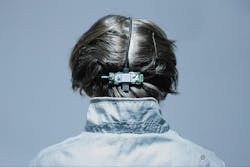Human Cyborg Gets Documentary Detailing His Journey of Augmentation
What you’ll learn:
- An overview of Cyborg: A Documentary.
- Insight into the integrated hardware.
- How technology is utilized to create different senses.
Take our Quick Poll below on becoming a cyborg.
Neil Harbisson is a Catalan-raised British-Irish-American cyborg artist and activist for transspecies rights. The artist is best known for being the first person in the world to have an antenna implanted into his head that allows him to hear colors, and the international media paints him as the first legally recognized cyborg after the UK government's passport office accepted his antenna as a body part. Now, he’s the subject of a new documentary detailing his journey to become a cyborg artist.
Harbisson was born with achromat vision, a form of color blindness that only lets him see shades of grey. He grew up learning to play the piano and started to compose music at the age of 11, and by the time he turned 16, he studied fine art at the Institut Alexandre Satorras, where he was given special permission to omit color in his work.
He defines his work as “cyborg art,” a process of designing new senses and organs and merging with them. Also known as cyborgism, the art movement, which began in the mid-2000s, is based on the creation and addition of new senses to the body via cybernetic implants and the creation of artworks using those new senses.
“Hearing” Colors with the Cyborg Antenna
Harbisson’s Cyborg Antenna (Fig. 1) is a sensory system designed to extend color perception. It was surgically implanted in his head, protruding out from within his occipital bone. It allows him to feel and hear colors, including those in the infrared and ultraviolet, as audible vibrations inside his head. A microchip implanted in his head translates those light frequencies and colors into vibrations, which he perceives via bone conduction, much like those of whales and dolphins while underwater.
His antenna also allows him to connect to the internet and experience color from other sensors or even satellites. According to Harbisson, his friends can beam colors, images, videos, or sounds directly into his head. If he receives those colors while asleep, his friends can alter the color of his dreams.
In 2014, he created the world's first skull-transmitted painting. Colors were sent from audience members in Times Square as they painted simple colored stripes onto a canvas, which he received live via Skype directly into his brain. He correctly identified and painted those same color stripes onto a canvas in front of an audience 10 blocks away.
Documentary Explores Harbisson’s Cyborg Experiences
Cyborg: A Documentary takes a look at Harbisson’s experiences through conversations with him, critics, cyborg enthusiasts, and his close friend and choreographer Moon Ribas (Fig. 2). Ribas also happens to be a cyborg and can sense when earthquakes are about to happen using implanted seismic sensors in her feet.
The documentary also highlights Harbisson’s abilities, including associating people and cities using different colors. For him, people who are black have very dark orange skin, while people who are white are perceived as very light orange. He even goes so far as saying he’s become more aware of health issues, certainly from having an antenna implanted in his head, noting that his IR and UV perception gives him insight into skin cancer
“If we could all perceive ultraviolet there wouldn’t be so many people with skin cancer,” said Harbisson. “You wouldn’t want to lie down and sunbathe if you could hear the terrible noise it makes.”
Foundation Formed for Cyborg Support
While Harbisson is still enthusiastic about his enhancements, he’s part of a movement of other artists interested in gaining new senses with cybernetic enhancements. In 2010, Harbisson and Ribas co-founded the Cyborg Foundation, an international organization based in NYC that defends cyborg rights, promotes cybernetic-based art, and supports those who want to become cyborgs.
The institution has donated cyborg antennas to blind communities, including Braille without Borders in Tibet and The Blind Society of Pichicha in Ecuador, and taught blind children how to use color-sensing to develop a sense of color.
Cyborg: A Documentary forces the viewer to consider some unorthodox questions—at what point does hardware integration alter who a person is, and what are the ethical implications? Bioethical committees repeatedly rejected Harbisson’s antenna implant surgery until he found anonymous doctors who would perform the surgery. We, as a society, have accepted the use of technology for medical purposes. Pacemakers, cochlear implants, shunt systems, and metal-to-metal hip implants are all considered normal as they help us continue to live.
But what about cosmetic implants? We’ve all accepted vanity as a human condition; more people today have Botox treatments, breast implants, and hair plugs than ever before. Elon Musk’s Neuralink aims to create human-machine interfaces via computer chips implanted in the brain, which is already underway with human trials.
Are antenna and sensors any different? Should people be free to create their own senses and augment their physiology with integrated technology? Those are some of the challenges posed in the documentary, but ultimately, it’s up to viewers to decide if integrated technology detracts from our humanity. Cyborg: A Documentary is currently screening at select UK theaters.
Check out the trailer for Cyborg: A Documentary and a video interview with Neil Harbisson:
About the Author
Cabe Atwell
Technology Editor, Electronic Design
Cabe is a Technology Editor for Electronic Design.
Engineer, Machinist, Maker, Writer. A graduate Electrical Engineer actively plying his expertise in the industry and at his company, Gunhead. When not designing/building, he creates a steady torrent of projects and content in the media world. Many of his projects and articles are online at element14 & SolidSmack, industry-focused work at EETimes & EDN, and offbeat articles at Make Magazine. Currently, you can find him hosting webinars and contributing to Electronic Design and Machine Design.
Cabe is an electrical engineer, design consultant and author with 25 years’ experience. His most recent book is “Essential 555 IC: Design, Configure, and Create Clever Circuits”
Cabe writes the Engineering on Friday blog on Electronic Design.



